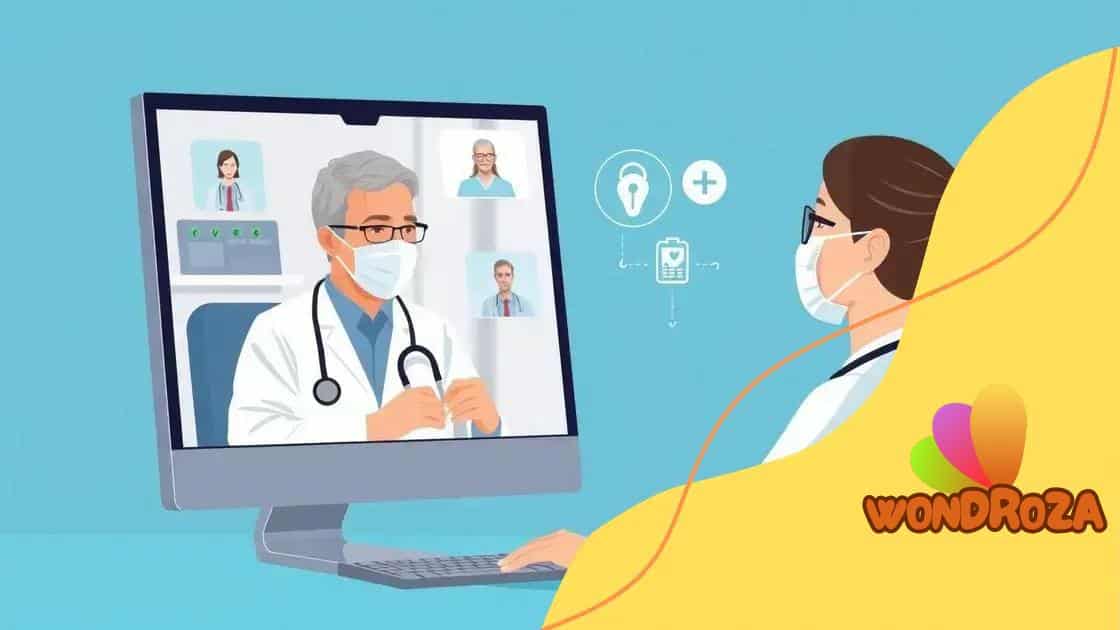How telemedicine is reshaping healthcare benefits

Telemedicine is reshaping healthcare benefits by improving accessibility, efficiency, and patient engagement, while also introducing challenges such as technology barriers and regulatory issues.
How telemedicine is reshaping healthcare benefits is a theme that captures the essence of modern medical service delivery. Have you ever considered how virtual consultations might improve your access to healthcare? Let’s dive into this transformative trend.
Understanding telemedicine’s evolution
Telemedicine has come a long way since its inception. Today, it stands as a cornerstone of modern healthcare, enhancing accessibility and convenience for patients. This evolution reflects advancements in technology and changing patient needs.
The Early Days of Telemedicine
Initially, telemedicine emerged as a means for doctors to consult with each other over long distances. The goal was to bridge the gap in care for patients living in remote areas. Telecommunications technology was the backbone of these early consultations.
Technological Advancements
As technology progressed, so did the methods used in telemedicine. With the rise of the internet, video conferencing became a reality, allowing for real-time interaction between patients and healthcare providers. This meant patients no longer had to travel for simple consultations.
- Increased access to specialists
- Reduced travel time for patients
- Enhanced communication between providers
- Lowered healthcare costs
These advancements have made it easier for people to receive healthcare from the comfort of their homes. Moreover, smartphone applications have allowed patients to monitor their health and communicate with their doctors seamlessly.
The Impact of COVID-19
The COVID-19 pandemic accelerated the adoption of telemedicine. With social distancing measures in place, many patients turned to virtual visits. Healthcare systems adapted quickly to meet the rising demand.
This shift highlighted the importance of virtual care in maintaining health during uncertain times. Patients found themselves appreciating the convenience of accessing care without the risk of exposure to viruses in waiting rooms.
As telemedicine continues to evolve, we can expect further innovations, including artificial intelligence-driven diagnostics and personalized care plans. The future of healthcare is indeed a blend of technology and personal touch.
Key benefits for patients
Telemedicine offers numerous advantages for patients, making healthcare more accessible and convenient. Understanding these benefits is important for anyone considering virtual care.
Convenience and Accessibility
One of the biggest benefits of telemedicine is its convenience. Patients can access medical care from the comfort of their homes, saving time and effort.
- No need for travel
- Appointment flexibility
- Shorter waiting times
- Access to specialists remotely
This easy access means that patients can quickly connect with healthcare providers whenever health issues arise. Additionally, remote care has been a lifesaver for those living in rural or underserved areas.
Improved Health Monitoring
Another key benefit is enhanced health monitoring. With the use of various apps and connected devices, patients can easily track their health metrics and share them with their doctors. This real-time data allows for better-informed medical decisions.
Many patients appreciate having their health information readily available, especially when it comes to chronic conditions. By staying on top of their health, they can manage issues more effectively.
Cost Savings
Telemedicine can also lead to significant cost savings. Since patients don’t need to travel for appointments, they save on transportation costs. Moreover, virtual visits can often be less expensive than in-person consultations.
- Lower copays and fees
- Reduced transportation expenses
- Less time taken off work
- Lower overall healthcare costs
These savings can make healthcare more affordable for many individuals and families, opening doors for those who might otherwise avoid seeking care.
Privacy and Comfort
Many patients feel more comfortable discussing sensitive issues in a familiar environment. Telemedicine allows for privacy that traditional in-person visits may not always provide. This comfort can improve the quality of interactions between patients and their healthcare providers.
As telemedicine continues to evolve, it’s clear that these key benefits make it an attractive option for a variety of patients. With ongoing support from technology, the patient experience is likely to improve even further.
Telemedicine’s impact on healthcare providers

Telemedicine has had a significant impact on healthcare providers, changing the way they deliver care and interact with patients. Understanding these effects helps highlight the importance of this modern approach to healthcare.
Enhanced Patient Engagement
One of the most notable impacts is the enhancement of patient engagement. With virtual visits, providers can communicate more frequently with their patients. This ongoing interaction fosters stronger relationships and improves patient adherence to treatment plans.
- More frequent check-ins
- Improved follow-up appointments
- Greater accountability for patients
- Increased patient satisfaction
Providers often find that patients are more willing to discuss their health issues in a comfortable setting. This leads to better-informed decisions regarding treatment and overall care.
Increased Efficiency
Telemedicine allows healthcare providers to see more patients in a shorter amount of time. Virtual consultations eliminate the need for travel, making scheduling more flexible for both parties. As a result, the efficiency of care delivery improves.
This uptick in efficiency can alleviate pressure on healthcare systems, especially during peak times. By maximizing their time, providers can focus more on what matters—delivering high-quality care to patients.
Access to a Broader Patient Base
With telemedicine, healthcare providers can reach a diverse range of patients. Specialists can offer services to individuals in remote areas who may lack local access. This opens up doors for many patients who previously faced challenges in obtaining care.
- Minimized geographical barriers
- Broader scope for specialists
- Increased diversity in patient demographics
- More comprehensive healthcare delivery
Providers can expand their practice without the need for additional physical locations, ultimately enhancing healthcare accessibility.
Data-Driven Insights
Telemedicine also provides healthcare providers with valuable data. The use of digital tools allows for better tracking of patient outcomes and health trends. These insights can inform improvements in practice and drive better health strategies.
By utilizing data analytics, providers can tailor their services to meet the needs of their patient populations more effectively. This evidence-based approach enhances overall healthcare quality and ensures that patient care is continually being improved.
Challenges in implementing telemedicine
While telemedicine brings numerous benefits, it also faces several challenges that can hinder its implementation. Understanding these hurdles is essential for improving how virtual healthcare is delivered.
Technology Barriers
One major challenge is the reliance on technology. Not all patients have access to the necessary devices or a stable internet connection. This digital divide can prevent many individuals from benefiting from telemedicine.
- Limited access to smartphones or computers
- Inadequate internet service in rural areas
- Technological knowledge gaps among patients
- High costs for technology maintenance
These issues can discourage patients from using telemedicine, ultimately limiting their access to vital healthcare services.
Regulatory and Legal Issues
Regulatory barriers also play a significant role in the adoption of telemedicine. Each state has different laws concerning virtual care, including licensure and reimbursement policies. This patchwork of regulations can create confusion for providers.
Healthcare providers must navigate complex legal landscapes, which may vary significantly from location to location. Inconsistent insurance coverage for telemedicine services can also deter both providers and patients from choosing virtual appointments.
Security and Privacy Concerns
An important challenge involves ensuring the security and privacy of patient data. With telemedicine, sensitive health information is shared over the internet. This raises concerns about data breaches and unauthorized access.
- Ensuring compliance with HIPAA regulations
- Implementing secure communication channels
- Protecting patient information from cyber threats
- Maintaining trust between patients and providers
Addressing these privacy issues is crucial for encouraging patients to embrace telemedicine. Providers must implement robust security measures to safeguard their patients’ data.
Provider Training and Adaptation
Healthcare providers must also adapt to new technologies and processes. Training staff to effectively use telemedicine tools can be time-consuming and resource-intensive. Some providers may resist change due to unfamiliarity with the technology.
Ongoing training and support are essential for ensuring that healthcare professionals can comfortably use telemedicine platforms. By investing in training, healthcare organizations can improve the quality of virtual care.
Future trends in telemedicine
The future of telemedicine is bright, filled with exciting developments that will reshape healthcare. As technology continues to evolve, telemedicine will become more integrated into everyday medical practice.
Increased Use of Artificial Intelligence
One significant trend is the increased use of artificial intelligence (AI) in telemedicine. AI can enhance patient care by providing personalized treatment plans based on health data. Additionally, AI algorithms can help in diagnosing conditions more accurately and quickly.
- Predictive analytics for patient health
- AI-driven chatbots for initial consultations
- Remote monitoring through smart devices
- Enhanced decision support for healthcare providers
This integration of AI will streamline processes and improve the efficiency of virtual healthcare services.
Telehealth Integration with Wearable Devices
Another trend is the growing relationship between telemedicine and wearable health devices. These devices can track vital signs and other health metrics in real-time, allowing providers to monitor their patients more effectively.
As wearables become more popular, doctors can receive continuous data on their patients’ health, leading to better-informed decisions. This development will empower patients to take more control of their health.
Regulatory Changes Supporting Telehealth
Regulatory bodies are starting to recognize the importance of telemedicine, leading to changes in legislation. More states are implementing laws that make it easier for providers to offer telehealth services.
- Expanded insurance coverage for virtual visits
- Streamlined licensing processes for telemedicine practitioners
- Increased support for telehealth access in underserved areas
- Better reimbursement models for remote care
These regulatory changes will encourage more healthcare providers to adopt telemedicine, significantly expanding access to care.
Focus on Mental Health
The emphasis on mental health care will also grow in the coming years. Telemedicine offers unique opportunities for individuals seeking mental health support. Virtual therapy sessions and mental health apps will become more widely accepted and utilized.
This shift acknowledges the importance of mental well-being and the convenience that telemedicine provides in accessing therapy and support.
FAQ – Frequently Asked Questions about Telemedicine
What are the main benefits of telemedicine for patients?
Telemedicine offers increased accessibility, convenience, and improved health monitoring for patients, allowing them to receive care from home.
How does telemedicine impact healthcare providers?
Telemedicine enhances provider efficiency, increases patient engagement, and allows access to a broader patient base, benefiting overall healthcare delivery.
What challenges do healthcare professionals face when implementing telemedicine?
Challenges include technology barriers, regulatory issues, security concerns, and the need for provider training to effectively use telemedicine tools.
What future trends can we expect in telemedicine?
Future trends include increased use of artificial intelligence, integration with wearable devices, enhanced focus on mental health, and improved regulatory support.





